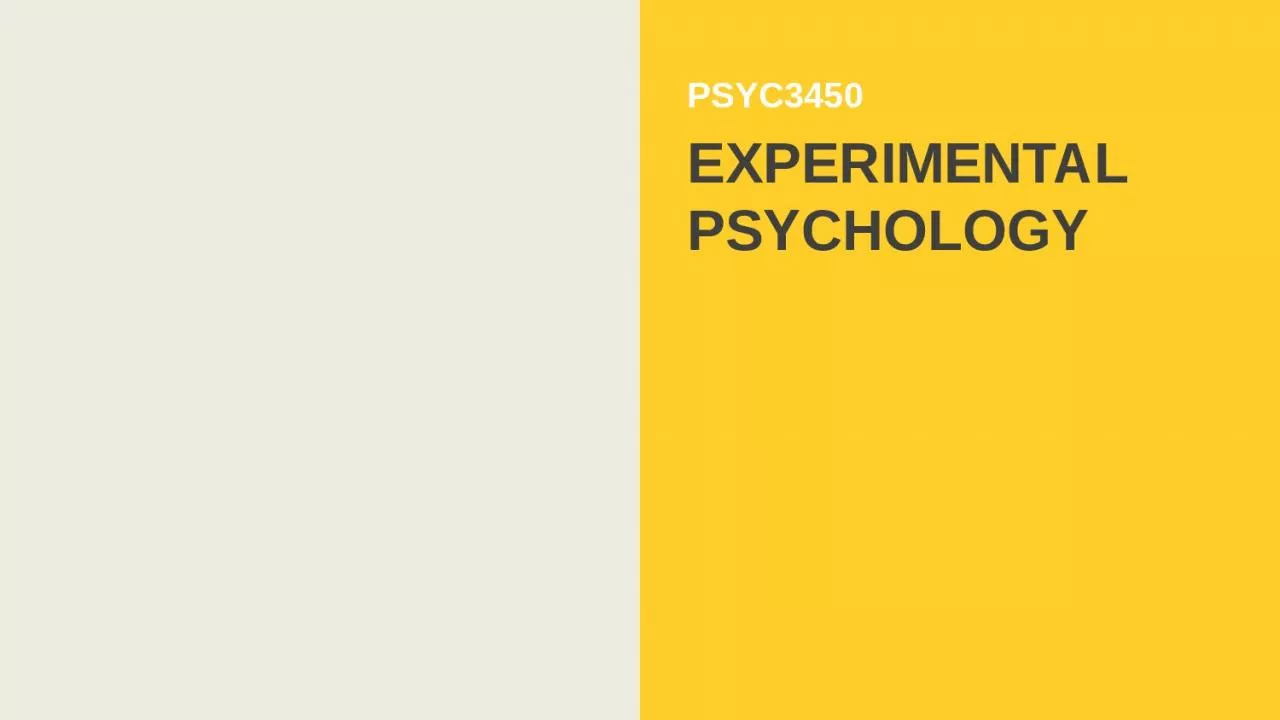

SingleSubject Small N Designs CHAPTER 11 Lecture Outline The Beginnings of Psychology Research Reasons for Small N Designs Applied Behavior Analysis ABA Case Study Designs THE BEGINNINGS OF PSYCHOLOGY RESEARCH ID: 1002442
Download Presentation The PPT/PDF document "PSYC3450 EXPERIMENTAL PSYCHOLOGY" is the property of its rightful owner. Permission is granted to download and print the materials on this web site for personal, non-commercial use only, and to display it on your personal computer provided you do not modify the materials and that you retain all copyright notices contained in the materials. By downloading content from our website, you accept the terms of this agreement.
1. PSYC3450EXPERIMENTAL PSYCHOLOGY
2. Single-Subject / Small N DesignsCHAPTER 11Lecture OutlineThe Beginnings of Psychology ResearchReasons for Small N DesignsApplied Behavior Analysis (ABA)Case Study Designs
3. THE BEGINNINGS OF PSYCHOLOGY RESEARCHMost early research in Psychology…Small NData not summarized; data for each subject presentedAdditional subjects used for replicationDresslar’s facial vision study (1892)falsification thinking
4. REASONS FOR SMALL N DESIGNSMisleading results from statistical summaries of grouped data A failure of individual-subject validity (e.g. discrimination learning research in children)Grouped data suggested gradual learningIndividual data suggested hypothesis testing and quick solutions once proper hypothesis foundSolution: children reach criterion at different ratesPractical problems with large N designsParticipants with a particular attribute are rareE.g. OCD occurs in <2% of the populationMembers of a specific animal species are rare, costly, or require too much time for trainingContinuitytheoryNon-continuity theory
5. THE EXPERIMENTAL ANALYSIS OF BEHAVIOROperant ConditioningBehavior conditioned in a particular environment by consequences (e.g. reinforcement)Primary DV rate of responseRecorded cumulatively
6. THE EXPERIMENTAL ANALYSIS OF BEHAVIORApplied Behavior AnalysisContemplative (understanding basic causes of events) vs. technological ideal (using science for control)Skinner using science to achieve controlThe issue of controlComparing Watson and SkinnerAttempt to control societyUse of punishment for controlling self-destructive behaviorsJustified?E.g. Judge Rotenberg Center, Canton, MA
7. SMALL N DESIGNS IN APPLIED BEHAVIOR ANALYSISElements of Single-Subject Designs Importance of operational definitions (again); what constitutes a child’s problematic behavior?Baselines establishedIntroduce some treatmentSimplest format: A – B designA = baselineB = treatmentWithdrawal Designs A-B-ATreatment (B) introduced, then withdrawnTo see if behavior change correlates with treatment changeA-B-A-BTreatment (B) evaluated twiceExperiment ends with treatment in placeA-B DesignA-B-A DesignA-B-A-B Design
8.
9. A-B-A-B DesignResearch Example: Differential Reinforcement of Alternative Behavior (DRA)Peer-mediated reinforcement of on-task behaviors for ADHD childrenExternal validity issue: laboratory study may not generalize to classroom SMALL N DESIGNS IN APPLIED BEHAVIOR ANALYSIS
10. Multiple-Baseline DesignsThree varietiesOne behavior, two or more subjectsTwo or more behaviors, one subjectTwo or more environments, one behavior, one subject SMALL N DESIGNS IN APPLIED BEHAVIOR ANALYSIS
11. Changing criterion designsFor behaviors that must be changed graduallyOperant principle of shaping SMALL N DESIGNS IN APPLIED BEHAVIOR ANALYSIS
12. Alternating treatments designCompares relative effectiveness of two or more treatments SMALL N DESIGNS IN APPLIED BEHAVIOR ANALYSIS
13. 01External validity issuesVisual inspection instead of statistical analysis, although this is changingHard to test interaction effects; effect on one type of person but not another? SMALL N DESIGNS IN APPLIED BEHAVIOR ANALYSISEvaluating single-subject designs
14. Survey ResearchCase studyA detailed analysis of single individual or eventIncorporates other methods (e.g. observation, psychometric tests)Individual (both clinical and non-clinical cases)Effects of head trauma in a boxerThe mind of a mnemonistAutistic savantsEventResponse to catastrophic event CASE STUDY DESIGNS
15. Survey ResearchEvaluating case studiesLevel of detail not found elsewhereCan serve falsification (Remember Hans?)Limited controlExternal validity issuesFaulty memory problems CASE STUDY DESIGNS